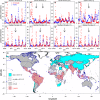Global Spatio-temporal Patterns of Influenza in the Post-pandemic Era
- PMID: 26046930
- PMCID: PMC4457022
- DOI: 10.1038/srep11013
Global Spatio-temporal Patterns of Influenza in the Post-pandemic Era
Abstract
We study the global spatio-temporal patterns of influenza dynamics. This is achieved by analysing and modelling weekly laboratory confirmed cases of influenza A and B from 138 countries between January 2006 and January 2015. The data were obtained from FluNet, the surveillance network compiled by the the World Health Organization. We report a pattern of skip-and-resurgence behavior between the years 2011 and 2013 for influenza H1N1pdm, the strain responsible for the 2009 pandemic, in Europe and Eastern Asia. In particular, the expected H1N1pdm epidemic outbreak in 2011/12 failed to occur (or "skipped") in many countries across the globe, although an outbreak occurred in the following year. We also report a pattern of well-synchronized wave of H1N1pdm in early 2011 in the Northern Hemisphere countries, and a pattern of replacement of strain H1N1pre by H1N1pdm between the 2009 and 2012 influenza seasons. Using both a statistical and a mechanistic mathematical model, and through fitting the data of 108 countries, we discuss the mechanisms that are likely to generate these events taking into account the role of multi-strain dynamics. A basic understanding of these patterns has important public health implications and scientific significance.
Figures




References
-
- Cox N. & Subbarao K. Global epidemiology of influenza: past and present. Annual Review of Medicine 51, 407–421 (2000). - PubMed
-
- Potter C. W. A history of influenza. Journal of Applied Microbiology 91, 572–579 (2001). - PubMed
-
- Simonsen L. The global impact of influenza on morbidity and mortality. Vaccine 17, S3S10 (1999). - PubMed
-
- Brownlee J. A further note upon the periodicity of influenza. The Lancet 201, 1116 (1923).
Publication types
MeSH terms
LinkOut - more resources
Full Text Sources
Other Literature Sources
Medical

